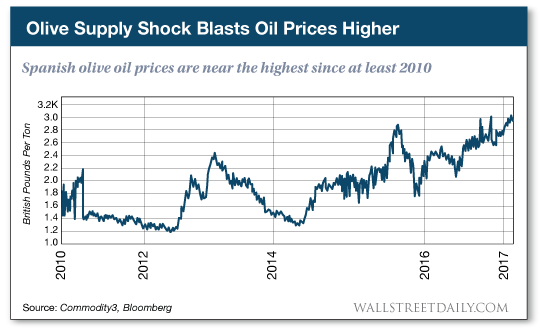In the lucrative world of small-cap investing, a supply/demand imbalance always piques my interest.
Those who position themselves alongside a fantastic supply shortage are virtually assured to profit.
Let’s take the prevailing shortage of olives as a simple example.
Erratic weather in Italy, Greece and Spain has been wreaking havoc on regional harvests, and no crop is more sensitive to climate irregularities than olives.
In Italy, hot and muggy conditions were perfect for fruit flies, and they ravaged olive groves. Consequently, Italy’s olive production will fall by 50%.
Worse yet, when you combine Italy’s plight with a heat wave in Greece and floods in Spain — the olive market is in a full-blown supply crisis.
Now, assuming that olive demand remains constant, the price of olives and olive derivatives must adjust upwardly, which is exactly what’s happening.

So how do investors benefit?
It’s simple, really…
During shortages, suppliers can charge higher prices, which flow straight to the bottom line — resulting in higher stock prices.
The bottom-line impact is even greater in the small-cap world, as such stocks are known for their upward volatility.
Bottom line, I’m aware of every shortage happening in the world — even of olives.
Unfortunately, there’s no direct way to invest alongside the explosion of olive prices.
But that’s OK — another supply shortage is beginning to get serious. And this particular supply shortage is something we can play, too.
I asked my senior analyst, Martin Hutchinson, to get you up to speed.
Copper is on a tear so far in 2017, with the base metal up 11% on the London Metal Exchange.
I’m very bullish on the trend continuing, which puts a small-cap Canadian miner in the cross hairs
The stout miner I’m tracking is enjoying increased production from its copper mines in Canada and Peru, and the company also has a mine in Arizona gaining traction.
But before I reveal the company, I’ll break down my top five bullish forces that will keep copper shining in 2017.
Bullish Force #1: Monetary Policy Worldwide
Now that the world economy is growing again, a decade of ultraloose monetary policies has led to higher inflation and faster growth in commodity prices.
Copper is in a prime position to benefit in an inflationary environment.
Bullish Force #2: Faster U.S. Growth
President Trump’s plan to spend on infrastructure — along with his deregulation initiatives — is beginning to produce a burst of faster growth in the United States.
The S&P 500’s 11% uptick since early November doesn’t hurt, either.
Since U.S. growth is bound to impact global growth as well, copper will benefit.
Copper, known traditionally as “Dr. Copper,” is the one commodity most sensitive to the state of the global economy.
Thus, economic sluggishness in 2012–16 caused its price to decline.
But the opposite is happening in light of the recent growth spurt, which is already reflected in higher copper prices this year.
Bullish Force #3: Restricted Supply
The next major increase to the global copper supply won’t happen until mining begins at Mongolia’s Oyu Tolgoi project, which is controlled by Turquoise Hill Resources.
However, construction has yet to start.
The political risks in Mongolia are substantial, and mining operations won’t come on-line until 2020 at the earliest.
Meanwhile, output from Chile’s copper mines is declining. And Freeport-McMoran Copper & Gold’s (NYSE:FCX) Grasberg mine, in Indonesia, has restricted supply even more.
The Indonesian mine is bedeviled by labor unrest and an increasingly nasty long-running dispute between FCX and the Indonesian government.
Bullish Force #4: Electric Vehicles
Every Tesla (NASDAQ:TSLA) electric vehicle uses three times the amount of copper as a conventional internal-combustion vehicle.
Moreover, Tesla intends to produce some 500,000 vehicles in 2018.
Tesla’s increased output alone will add 35,000 tons to copper demand.
Oh, and Tesla isn’t alone in its plans to ramp up production of electric vehicles.
So copper demand will rise more rapidly than analysts’ projections.
Bullish Force #5: The Supply/Demand Imbalance
Copper demand was expected to exceed supply by 2019 even without my two accelerating factors (faster economic growth and increased electric vehicle production).
Once we account for those factors, the supply/demand imbalance will further spark copper’s ascent.
Of course, to invest alongside higher prices, we could buy shares in one of the major copper companies.
The most solid in terms of supply and political risk is Southern Copper Corporation (NYSE:SCCO).
But to gain greater leverage, I recommend midsize miner HudBay Minerals Inc. (TO:HBM) — a $2 billion capitalization company that produces copper, gold and zinc.
The company’s mines are located in Peru and Canada — and it also runs a stateside operation in Arizona.
I particularly like how levered Hudbay Minerals is to the price of copper, as copper represents roughly two-thirds of revenue.
The latest regulatory filings looked good across the board…
Copper production was up 19%, gold production was up 14%, silver production was up 34% and zinc production was up 8%.
It’s worth noting that low copper prices and the launch of a new Peruvian mine meant a breakeven year in 2016.
However, its cost of production (after subtracting credits for other products) was $1.52 per pound, which lies well below 2016’s copper price and far below copper’s current price of $2.74.
With operating cash flow of $122 million against total debt that sits at 72% of equity, I believe Hudbay Minerals is a real bargain.
Throw in a dividend of $0.02 per share and you’ve got the perfect åinvestment to benefit from higher copper prices.
